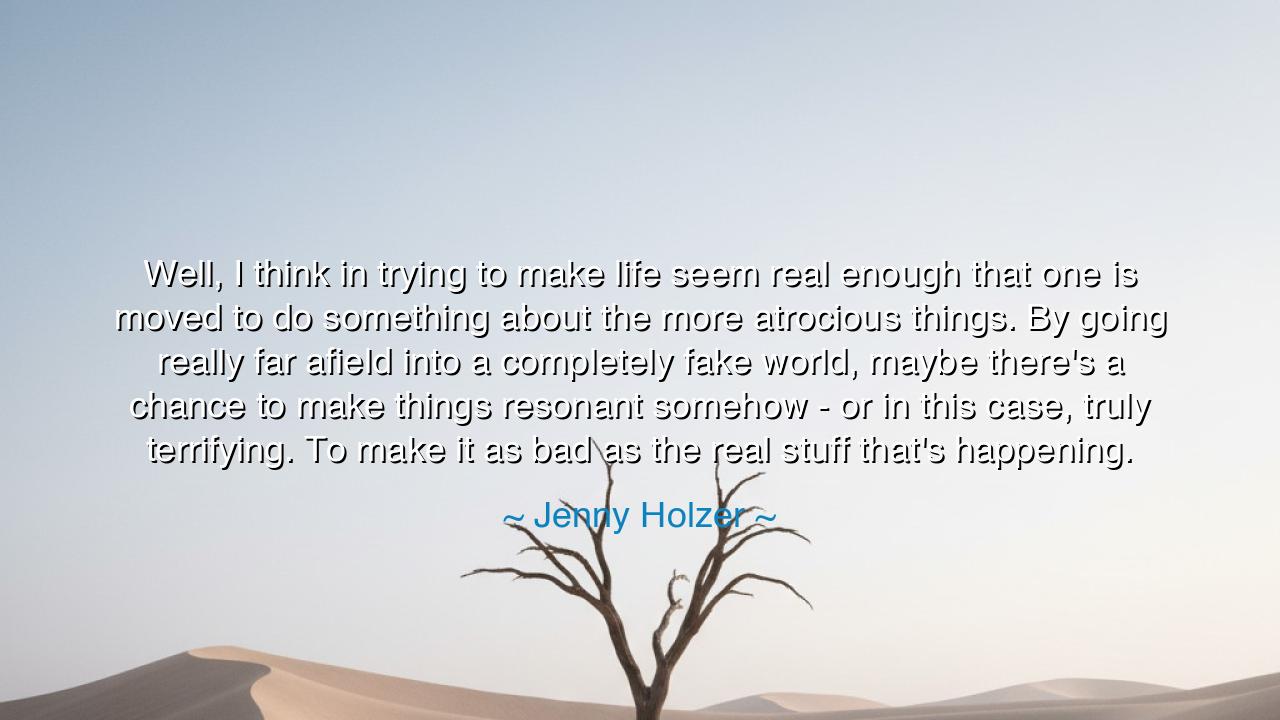
Well, I think in trying to make life seem real enough that one is
Well, I think in trying to make life seem real enough that one is moved to do something about the more atrocious things. By going really far afield into a completely fake world, maybe there's a chance to make things resonant somehow - or in this case, truly terrifying. To make it as bad as the real stuff that's happening.





In the vast, ever-shifting sea of human existence, there are moments when the heart of man is stirred, when the soul is awakened to the suffering that quietly gnaws at the fabric of the world. Jenny Holzer, a seeker of truth and the power of art, speaks of a profound desire to reach the depths of human understanding and empathy. She suggests that in order to stir the hearts of those who are blind to the atrocities of the world, one must sometimes venture far beyond the ordinary, into a completely fake world—a realm born of imagination and art. There, within this constructed reality, there may lie the chance to strike at the very core of human emotion, to touch the soul in ways that the stark, unadorned truth cannot.
The fake world that Holzer speaks of is not a retreat from reality, but rather a means to amplify the truth. By creating something that is, in its essence, unreal, an artist can magnify the suffering of the real world, presenting it in such a way that it shakes the viewer to their core. It is the very artifice, the constructed nature of this world, that allows the viewer to engage with it more deeply, to confront the horrors of reality through a lens that is more intense, more charged. Holzer’s art is a challenge to the complacency that often blankets the human spirit; it forces us to look at suffering not as an abstraction, but as something that resonates deeply, something that can no longer be ignored.
This truth is not new. The ancients understood the power of illusion to convey the deepest realities. Consider the Greek tragedies, which, though staged in elaborate, fictional worlds, sought to teach the audience profound truths about life, fate, and suffering. Sophocles, in his mighty play Oedipus Rex, created a world of kings and gods, yet the torment of his characters, their blindness to truth, and their inevitable downfall spoke directly to the very human condition. Through the fake world of the theater, the Greeks were able to confront the real evils of pride, ignorance, and fate that they could not directly face in their own lives. The lesson was clear: art, in its most elevated form, provides a space where the soul can face what the body dares not.
Similarly, Jenny Holzer’s words echo the wisdom of those who came before her, for her art seeks to make the atrocities of the world resonant in a way that forces us to confront them. She does not simply present the real horrors—those visible in war, oppression, and suffering—but she builds a world of intensity, one that is as terrifying as the suffering itself. By doing so, she makes the viewer not just observe, but feel, not just see, but understand the visceral nature of what is happening. Her art, in its extremity, compels us to act. It is not enough to simply be moved by the image; one must also be moved to act, to change the course of things.
History bears witness to this powerful connection between artifice and truth. In times of war, when brutality seemed to consume the very spirit of humanity, it was often artists who spoke the loudest. Picasso’s Guernica, though a reflection of an event that transpired in the real world, was not a simple depiction of reality. It was a distorted, anguished scream that conveyed the true horror of war. Its fragmented and chaotic form, its starkness and despair, made the viewer feel the pain of the innocent, and in doing so, awakened a collective urgency to change the course of history. Through this fake world, Picasso managed to show the true face of human suffering.
And now, dear listener, comes the lesson for us all. Holzer’s words remind us that in order to confront the darkest truths of our existence, we must be willing to dive into the unreal, to challenge our senses, to create spaces where the truth can be seen in its most terrifying light. This is not a call for escapism, but for a deeper engagement with the world around us. We are called not to shy away from the brutality of the world but to face it head-on, in whatever form it takes. Art, in its many forms, has the power to awaken the dormant parts of the soul, to shake the foundations of complacency, and to stir us into action.
Thus, let this be a guiding principle in your own life: seek out those moments of profound engagement, whether through art, story, or action, that compel you to face the truths that lie beneath the surface. Do not be satisfied with the easy comforts of ignorance or distraction. Instead, embrace the power of the fake world—the space where imagination allows the real world to be seen with new eyes. When you look upon suffering, do not look away; look deeper, understand it more fully, and let it move you to change. The world is full of atrocity, but it is also full of the potential for transformation. You, like the great artists before you, hold the power to make the real resonate, to make it so terrifying that no one can ignore it. And in this, perhaps, lies the chance for true change.






AAdministratorAdministrator
Welcome, honored guests. Please leave a comment, we will respond soon